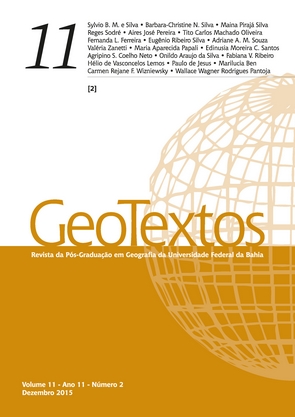COUNTRYSIDE EDUCATION ON THE EDGE OF THE “STRIP”: PLACE (IN)EXISTENCE AS PHENOMENON OF SPACIALISATION
DOI:
https://doi.org/10.9771/1984-5537geo.v11i2.13375Keywords:
Place/Placety, (In)existence, Trans-Amazon Highway, Countryside EducationAbstract
This text is part of an on going research. It deals with the relationship between the production and experience of the places on the edge of the Trans-Amazon Highway (BR 230), which cuts the North and a Northeast portion in the East-West direction. Considering its programmatic sense of occupation of the territory, as opposed to the explanation already accepted, which expresses the road as an engineering system, therefore, means to flow, is that I propose to think the road as an everyday living space, emphasizing the educational dimension to understand the existence of places. My purpose is to analyze the spatial imagination underlying the external understanding to the Trans-Amazon, in the educational plan, regarding the unique geographicity produced by local groups living near the road. Methodologically, I seek a dialogue between a phenomenological design and the existentialism, developing field of research procedures, literature review that supports the concepts of spatial imaginations, place and field education, critical reading of official documents in the MEC sites imagery record in dialogue with the representation of those that live on the edge of “Strip”. As an indication of preliminary findings point out: 1. The denial of places as a geopolitical strategy which is materialized in the educational process and planning politics; 2. The inescapable geographicity of groups that self recognize and are related contradictorily to the Trans-Amazon Highway; 3. The Countryside Education as opening or denial of the place, both for those who live it, and for those who do not live it, which can be ignorance widespread factor in terms of knowledge of the Amazon spatiality or coping and creation of a new geographic and cartographic knowledge about the places cut by “Strip”.Downloads
Downloads
Published
How to Cite
Issue
Section
License
Autores que publicam nesta revista concordam com os seguintes termos:
Autores mantém os direitos autorais e concedem à revista o direito de primeira publicação, com o artigo simultaneamente licenciado sob a Licença Creative Commons Creative Commons CC BY que permite o compartilhamento do trabalho com reconhecimento da autoria e publicação inicial nesta revista. Esta licença permite que outros distribuam, remixem, adaptem e criem a partir do seu trabalho, mesmo para fins comerciais, desde que lhe atribuam o devido crédito pela criação original. É a licença mais flexível de todas as licenças disponíveis. É recomendada para maximizar a disseminação e uso dos materiais licenciados. Ver o resumo da licença em: https://creativecommons.org/licenses/by/4.0/ Ver o texto legal da licença em: https://creativecommons.org/licenses/by/4.0/ Consulte o site do Creative Commons: https://creativecommons.org/licenses/?lang=pt
Autores têm autorização para assumir contratos adicionais separadamente, para distribuição não-exclusiva da versão do trabalho publicada nesta revista (ex.: publicar em repositório institucional ou como capítulo de livro), com reconhecimento de autoria e publicação inicial nesta revista.
Autores têm permissão e são estimulados a publicar e distribuir seu trabalho online (ex.: em repositórios institucionais ou na sua página pessoal) a qualquer ponto antes ou durante o processo editorial, já que isso pode gerar alterações produtivas, bem como aumentar o impacto e a citação do trabalho publicado (Veja O Efeito do Acesso Livre).






